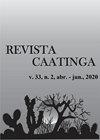旱地条件下豇豆地方品种的基因型x环境相互作用及稳定性
IF 0.9
4区 农林科学
Q3 AGRONOMY
引用次数: 1
摘要
摘要豇豆是半干旱地区研究的优秀作物,因为它能耐受高温和缺水,在雨水灌溉的种植中产量令人满意。本工作旨在评估巴西东北部半干旱地区帕拉伊巴卡里里地区豇豆地方品种的基因型x环境(G×E)相互作用、适应性和稳定性。该实验是在该地区的两个地点,在降雨条件下进行的。对于所评估的所有性状,G×E相互作用是简单的,这意味着所评估的地方品种可以推荐用于不同的测试环境。结果还表明,表型选择可以有效地提高豇豆地方品种的产量,因此可以由农民自己实践。最具优势的地方品种具有良好的稳定性(qi<5%)。尽管豇豆地方品种在不同环境中的性能标准相似,但在具有最佳环境保护历史和较高降水量的农场获得了最佳值。因此,在巴西东北部半干旱地区的可持续农业发展模式中,将豇豆地方品种的产量、农业景观的环境保护和考虑当地降水可能变化的战略规划相结合是至关重要的。本文章由计算机程序翻译,如有差异,请以英文原文为准。
Genotype x environment interaction and stability in landraces of cowpea under dryland conditions
ABSTRACT Cowpea (Vigna unguiculata (L.) Walp.) is an excellent crop for research in semi-arid regions, due to its tolerance to high temperatures and water deficit, with satisfactory yields in rain-fed cultivation. The objective this work was to evaluate the genotype x environment (G × E) interaction, adaptability and stability of cowpea landraces used in the Cariri, Paraíba, in the semiarid region of Northeast Brazil. The experiment was carried out under rain-fed conditions in two locations of this region. For all traits evaluated, the G × E interaction was simple, which means that the evaluated landraces can be recommended for the different environments tested. The results also suggest that phenotypic selection can be efficient to enhance the yield of cowpea landraces and, therefore, can be practiced by the farmers themselves. The most advantageous landraces were ranked with good stability (qi <5%). Although the performance standards between the cowpea landraces were similar in the different environments, the best values were obtained on the farm with the best environmental conservation history and with higher precipitation. Therefore, the integration between the yield of cowpea landraces, environmental conservation in agricultural landscapes, and strategic planning that considers possible variations in local precipitation is essential in models of sustainable agricultural development in semi-arid zones of Northeast Brazil.
求助全文
通过发布文献求助,成功后即可免费获取论文全文。
去求助
来源期刊

Revista Caatinga
AGRONOMY-
CiteScore
2.10
自引率
11.10%
发文量
67
审稿时长
6-12 weeks
期刊介绍:
A Revista Caatinga é uma publicação científica que apresenta periodicidade trimestral, publicada pela Pró-Reitoria de Pesquisa e Pós-Graduação da Universidade Federal Rural do Semi-Árido – UFERSA, desde 1976.
Objetiva proporcionar à comunidade científica, publicações de alto nível nas áreas de Ciências Agrárias e Recursos Naturais, disponibilizando, integral e gratuitamente, resultados relevantes das pesquisas publicadas.
 求助内容:
求助内容: 应助结果提醒方式:
应助结果提醒方式:


